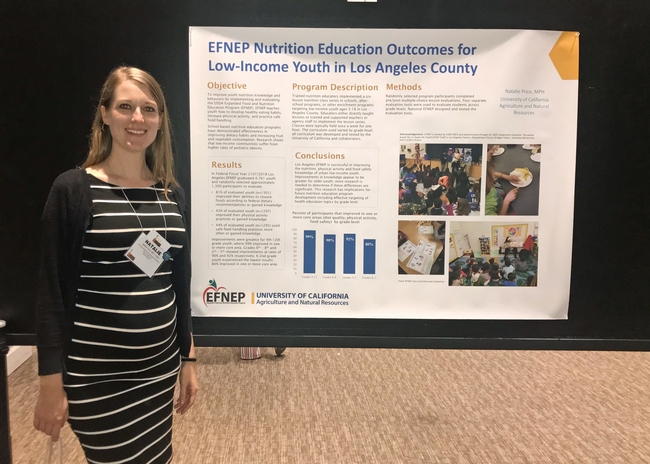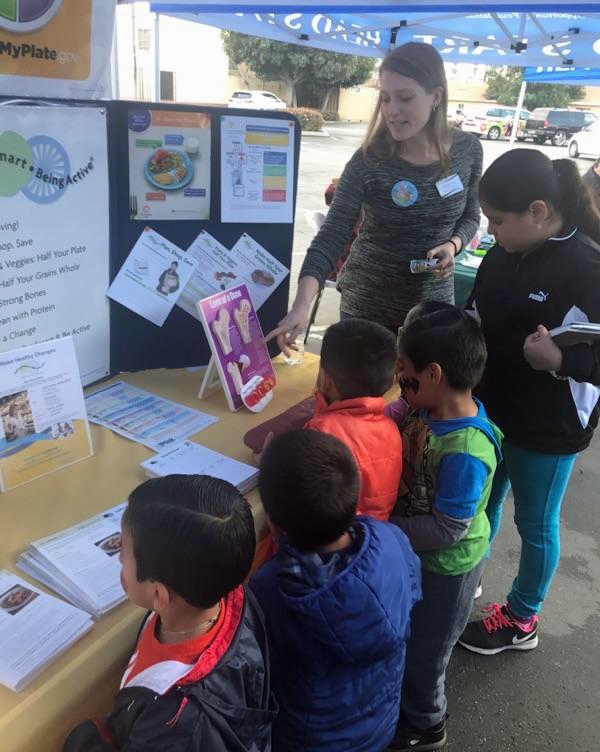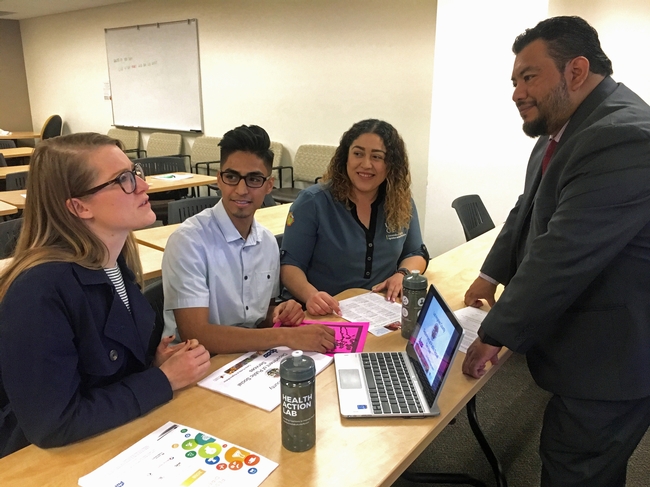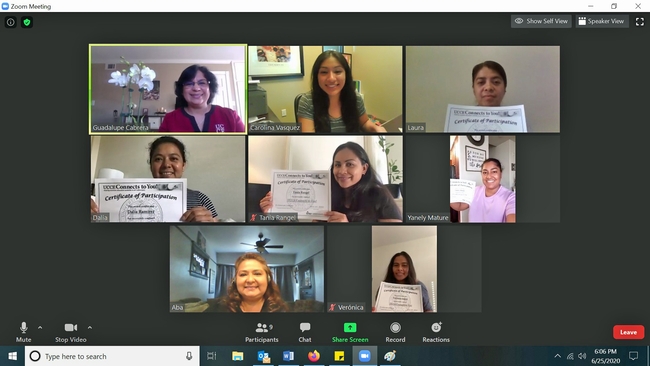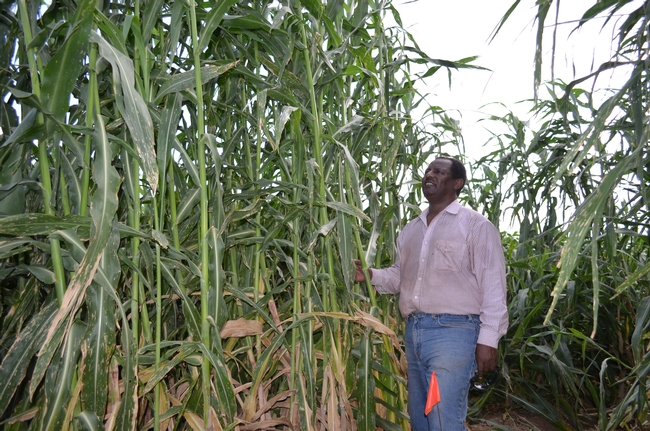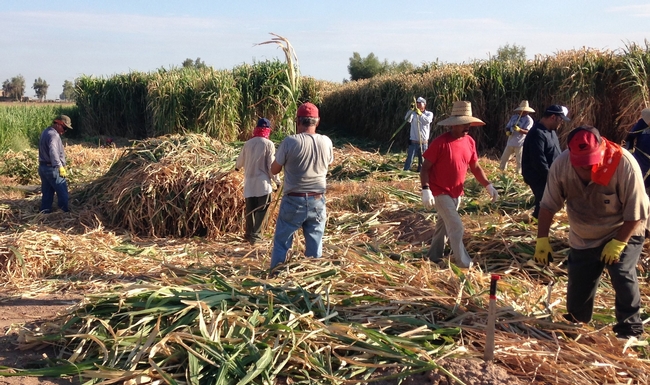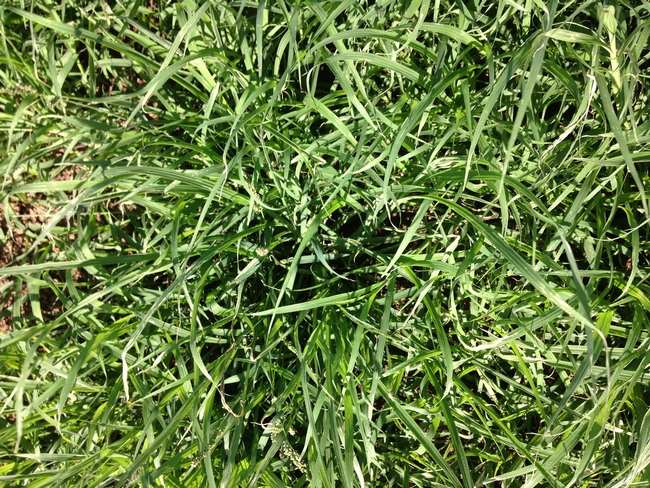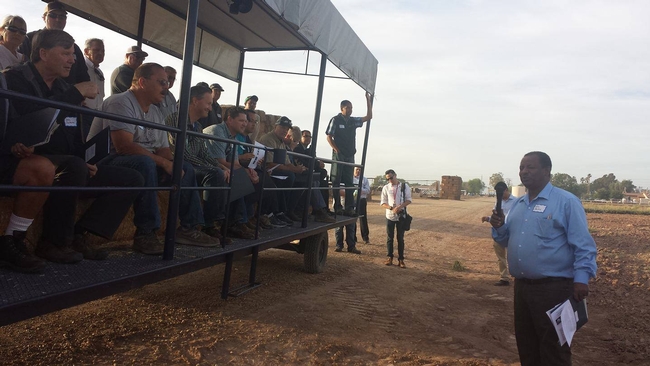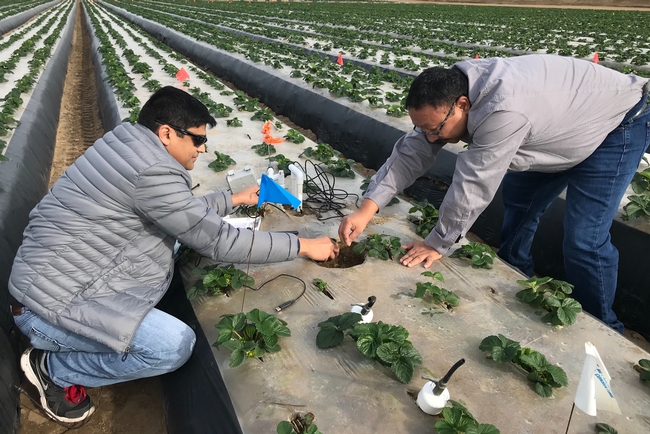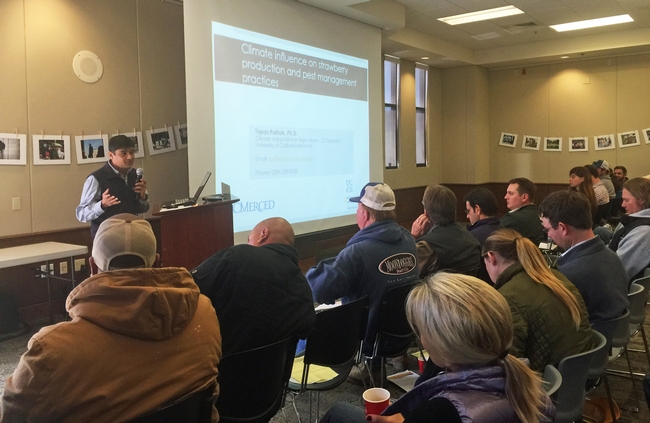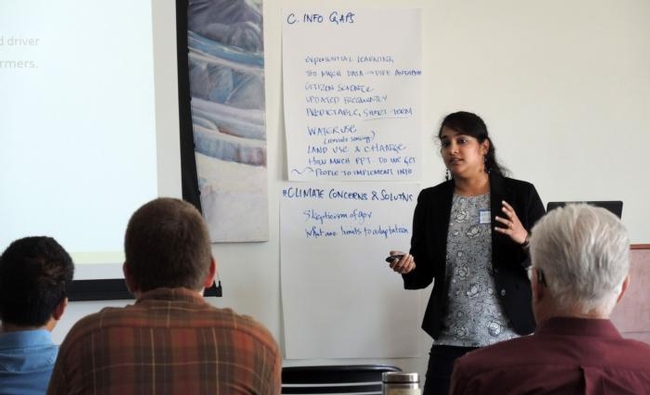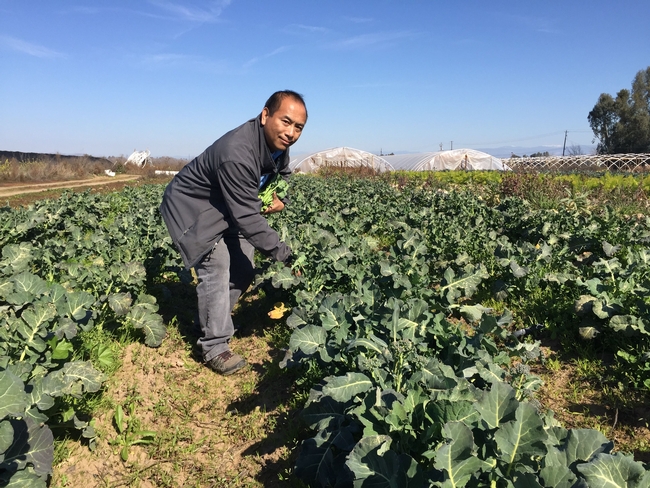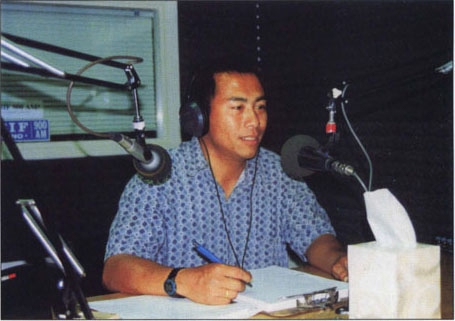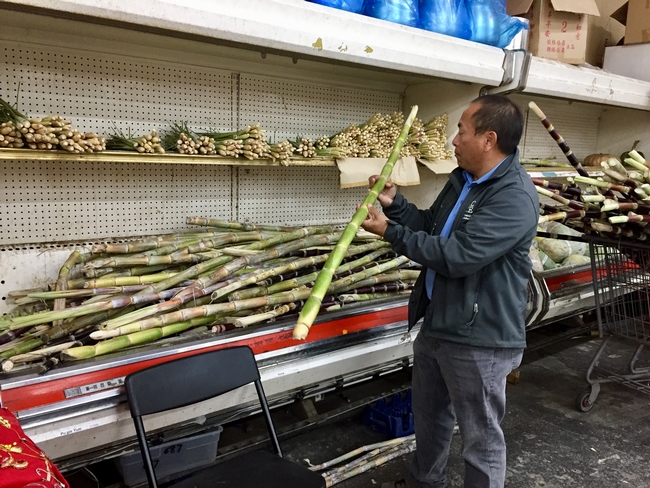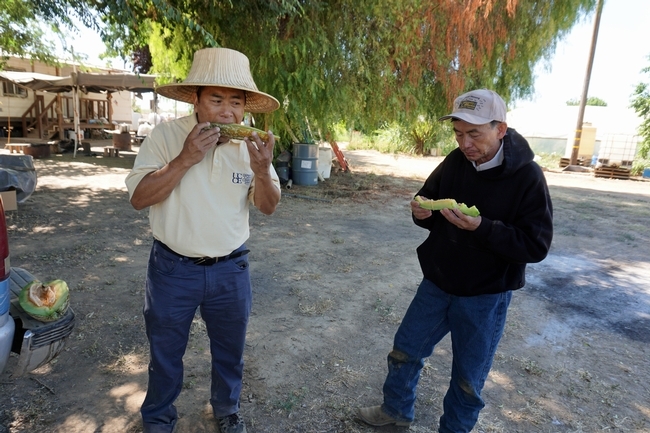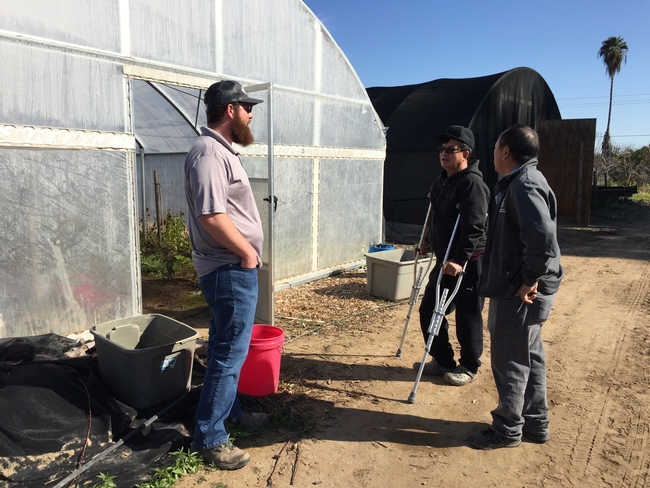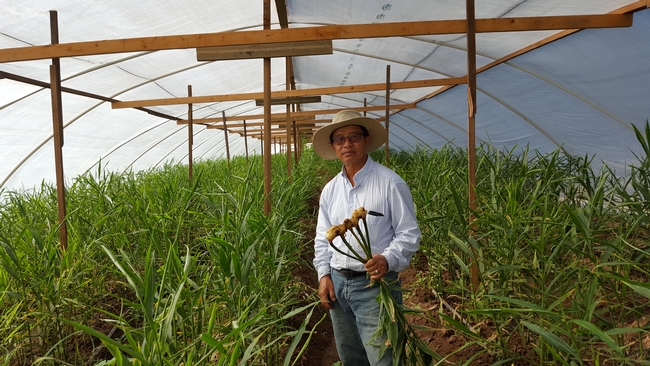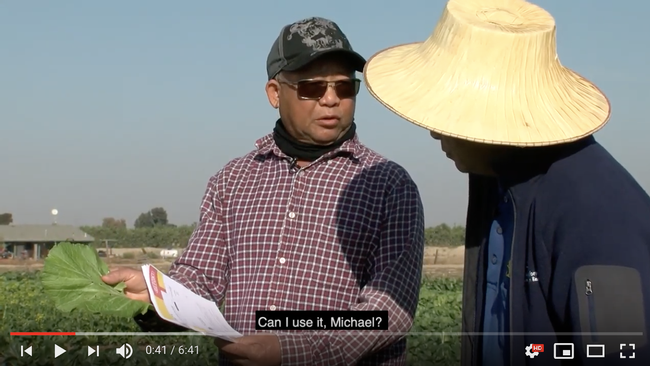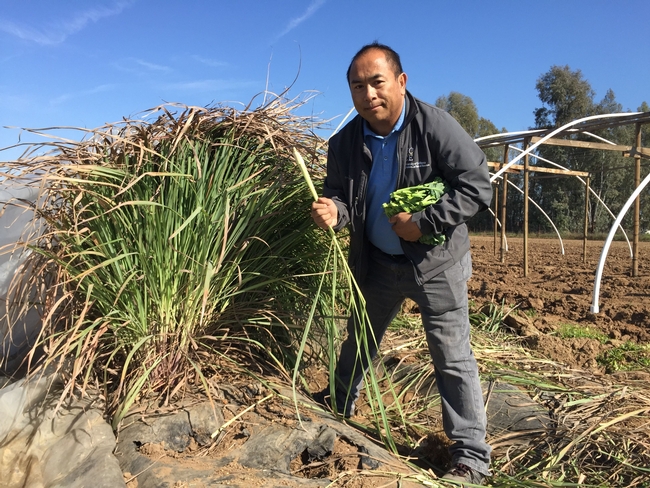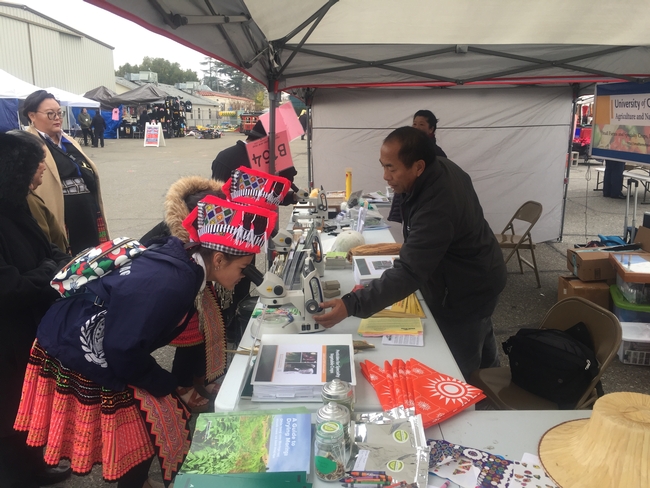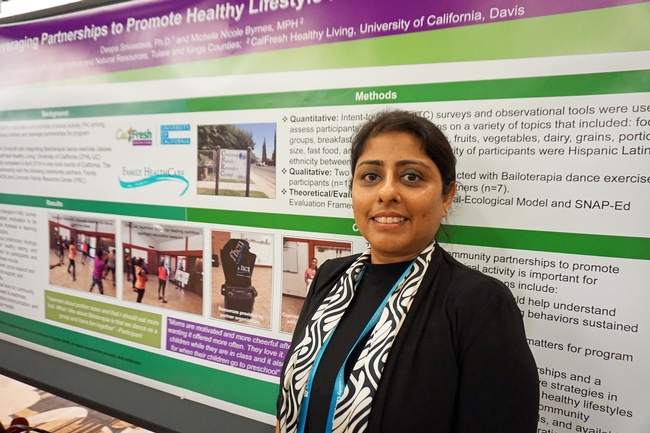Posts Tagged: public value
UCCE advisor works towards food security in Los Angeles and Orange counties
This is one of a series of stories featuring a sampling of UC ANR academics whose work exemplifies the public value UC ANR brings to California.
As an international development undergraduate at UCLA in the late 2000s, Natalie Price learned of the preventable health conditions prevalent in developing countries and wanted to be part of the solution. The Los Angeles native soon realized, however, that people in her own backyard were also struggling to keep their families healthy and well fed. She decided to join UC Cooperative Extension in Los Angeles and Orange counties to work towards improving food access and affordability for Southern California's most vulnerable residents.
“There's a lot of inequality in terms of pay and access to resources,” said Price, who was named UCCE nutrition, family and consumer sciences advisor in 2017. “I think access to healthy, affordable food is a fundamental human right, especially for kids. It is so important they have reliable food for physical development, mental health and school performance.”
Price earned a master's degree in public health at UCLA and worked for four years with the Los Angeles County Office of Education developing a school nutrition education program and school garden training. In her UCCE post, Price supervises Los Angeles and Orange counties' Expanded Food and Nutrition Education Program, in which nutrition educators visit schools to teach parents and youth to exercise regularly, eat a healthy diet and access resources that make achieving those goals easier.
“In Los Angeles and Orange counties, the cost of living is very high,” Price said. “A lot of families work multiple jobs and still can't comfortably pay their rent and buy the nutritious foods their families need.”
In southeast Los Angeles County, 32.4% of households with incomes under 300% of the Federal Poverty Level are considered food insecure, approximately 79,000 individuals, according to the Los Angeles Department of Public Health. Unable to take on such a daunting task on her own, Price co-chaired a food security symposium in 2019 that brought together 98 people representing 85 direct service organizations interested in taking collective action to serve food-insecure residents of southeast Los Angeles.
Of the symposium participants who completed an evaluation, 65% said they increased their awareness of the food resources available to help food-insecure individuals and families in their area and know how to access them, and 86% increased their understanding of current state and federal policies affecting food-insecure individuals and food assistance programs.
"Information about immigration will be shared with the people of the community, for instance, information about Public Charge,” wrote one participant about a segment of the symposium that outlined a federal policy negatively affecting food insecure immigrant populations. Many immigrants fear they could be denied legal status in the United States if they receive publicly funded services, however, the rule is frequently misunderstood and can lead to immigrants unnecessarily rejecting food assistance.
While Los Angeles and Orange counties are closely connected by freeways and economic activity, the two counties differ. During a needs assessment study in Orange County, Price found that the county was primed to work in food waste prevention. Limiting food waste can boost food security and reduce food waste in landfills, where anaerobic conditions may cause rotting food to emit greenhouse gases that contribute to climate change. Consumer food waste prevention education is a theme Price plans to tie into her work overseeing the UC Master Food Preserver Program. She was planning a food waste prevention campaign on social media when priorities had to be modified due to the worldwide coronavirus outbreak.
“Food insecurity went up dramatically with the shutdown of schools and businesses,” Price said.
She worked with her nutrition education staff to adapt their food security and affordability curriculum to offer it to families online.
“We're doing a lot of outreach and recruiting families to take our EFNEP course. Now we have our online classes up and running,” Price said. “Many parents with school-aged children are becoming familiar with online learning and have a device at home to participate in classes. However, for some, technology can still be a big barrier.”
Price is now working with her UCCE Tulare County colleague Deepa Srivastava to offer online video courses created by partner organization Leas' Pantry to teach families how to maintain a healthy diet while stretching their food dollars.
Former goat herder’s crop research promotes prosperity for Imperial Valley farmers
Oli Bachie, “person of the globe,” researches new desert crops to spur economic growth
While herding goats along dusty roads as a boy growing up in Oromia, Ethiopia, Oli Bachie began striving to improve his economic position in life. His path to a better life passed through the Philippines and Canada before reaching the United States. Now, carrying the mantle of Ph.D., the UC Cooperative Extension farm advisor is doing research to help California farmers take advantage of new opportunities for economic growth.
More than 400 different crops and animals are commercially produced in California. The wide array of agricultural products keep California farmers competitive in the global market. UC Cooperative Extension research into new crops provides growers with information that can lower the risk of trying something new.
Rhodes grass, giant king grass, quinoa and teff are among the crops Bachie has been studying since he joined UC Agriculture and Natural Resources in 2012.
“Giant king grass and Rhodes grass were brought to my attention by companies who wanted me to test their adaptability, biomass yield and nutrition as livestock feed,” Bachie said. “My findings proved that they indeed adapt and produce high biomass and were nutritionally competent or better than many of the low desert grown grass forage crops.”
Two companies provided Bachie with funding to conduct the research. “We do research for industries, companies and growers as long as they provide funding and if we believe that the outcome of the research benefits our clientele and the local economy,” he explained.
Viaspace, a company that grows giant king grass in 11 locations in eight countries on four continents, has relied on Bachie's research for establishing its plantings in the Imperial Valley.
“Oli's research helped us establish basic growing procedures and parameters for Imperial County. It provided the critical information that gave us the confidence to start a larger commercial effort in the desert,” said Haris Basit, vice chairman of Viaspace.
To share information with Imperial Valley growers, Bachie has presented his research results on Rhodes grass varieties at field days and workshops and published in the UCCE Imperial AgBrief newsletter and in the proceedings of the 2019 Western Alfalfa and Forage Crops Symposium. During the COVID-19 pandemic, he has been giving talks via Zoom on Rhodes grass as a new emerging crop, including a zoom workshop organized by the University of Arizona.
“Rhodes grass productivity is well-recognized and is adapted for production not only in the Imperial Valley, but also as far as San Joaquin County and in the state of Arizona,” he said. “A grower in Imperial has started to export Rhodes grass hay to the Middle East. More and more growers within the Imperial Valley and beyond are interested in growing Rhodes grass. I get lots of calls to answer Rhodes grass-related questions. There is now a Rhodes grass seed distributing company in Imperial Valley.”
Giant king grass – a hybrid of elephantgrass and Napier grass, which both grow well as wild plants in Ethiopia – and Rhodes grass are widely grown in Ethiopia. But Bachie didn't study these grasses until he joined UC Cooperative Extension.
Bachie grew up farming with his parents in the rural western part of Oromia, where most coffee and food crops are produced in Ethiopia. “By the way, the name ‘coffee' is derived from a place in Oromia called Kaffaa,” he noted.
“After school in winter, when most farming takes place, I engaged myself in farming,” Bachie said. That afterschool activity piqued his interest in farming and fueled his pursuit of a bachelor's degree in plant sciences from Haromaya University in Ethiopia.
“At that time, when I joined the university, there was only one university in the country,” he said. “I was lucky enough to be one of the few to get university admissions among thousands of high school students.”
In Ethiopia, he worked on a program sponsored by the Ministry of Agriculture and United Nations Food and Agriculture Organization for six years, mostly as a crop protection expert. He studied insects, weeds, pathogens and other crop pests on field crops, vegetables and horticultural crops.
“The experiences I gathered from Ethiopia help me provide services in Imperial County in multidisciplinary pest management – insects, pathogens, weeds and nematodes – at times when we did not have any pest management advisor in Imperial County,” he said. “It has also given me the opportunity to deal with clientele with easy transfer of scientific knowledge.”
Bachie was selected as an FAO fellow to pursue a master's degree in agronomy at the University of the Philippines.
“My area of particular concern then was to look at allelopathy (a chemical inhibition of plant extracts or exudates) as a potential inhibition of weed growth,” Bachie said. His plans to develop a biological weed management approach were disrupted when he graduated with a master's degree and he refused to return to his dictator-led home country.
“Ethiopia was then and is still ruled under a brutal government where educated personnel have little value,” he explained. After graduation, he sought settlement in another country. “That supportive state, which I thank dearly, was Canada.”
After earning a master's degree in forestry from the University of Toronto, Bachie accepted a job at a university teaching network administration and came to the U.S., where he earned a Ph.D. in biological sciences at UC Riverside, “Americanizing not only myself, but also my credential and now I serve UC with full interest and strength,” said Bachie, who holds dual U.S. and Canadian citizenship.
In the spring of 2019, Bachie started comparing grass forage crops (bermudagrass, kleingrass, Rhodes grass and teff) with moringa for livestock feed under low desert conditions. Growers will be able to use the research results to decide which crops will be most profitable for their own operations.
Last summer, Bachie completed a variety trial of quinoa, a grain grown primarily for its edible seeds. He tested the adaptability and grain yield of 35 varieties of quinoa in the heat and biotic stress of the Imperial Valley.
“Of the tested varieties, many tolerated the high heat of the desert and gave promising yields,” said Bachie, who showed the varieties to farmers at an agronomy and irrigation crops field day. “The high grain prices of quinoa in the U.S. and the proof of adaptability and yielding capacity under the low desert condition is expected to attract some growers to grow some quinoa varieties in the Imperial Valley.”
Bachie recently completed a survey of weeds in the county and is planning to publish a handbook titled “Weeds of Imperial County and Management Approaches.”
“While my journey is a huge zigzag and I came up through difficulties, I am very glad that I was able to travel and survive and made myself from a goat herder to an American Ph.D.,” said Bachie, who has also taught biology and environmental science courses part time at Victor Valley and Imperial Valley community colleges, respectively.
“My travel all over the world has enhanced my concepts of human diversity and the affinity to associate and work with people of various backgrounds. To be sure, I call myself a person of the globe.”
Climate-change research provides tools for farmers to adapt
This is one of a series of stories featuring a sampling of UC ANR academics whose work exemplifies the public value UC ANR brings to California.
Farmers are already seeing the effects of warmer winter nights and hotter summer days on their crops. Climate change is gradual, but increasing overall temperatures affect many aspects of farming, including where and how crops are grown. Tapan Pathak, University of California Cooperative Extension specialist based at UC Merced, is doing applied research that farmers and ranchers can use to adapt to new conditions created by a variable and changing climate.
“You don't have to shift your practice tomorrow, but if you are thinking of making a 30-year investment, it's important to know what risks there are for planting different crops,” said Pathak, who is based in the Sierra Nevada Research Institute at UC Merced.
Pathak co-chairs the UC Cooperative Extension Climate Change Program Team, whose mission is to increase the capacity among UCCE academics to address climate change concerns with science-based information. Pathak also collaborates with extension professionals from across the western U.S. to do extension events related to climate change adaptation. He works closely with state and federal agencies statewide and growers to identify changes occurring as a result of climate change that affect agriculture. Pathak's research will inform growers' decisions, such as crop variety, planting and harvest dates, extreme heat and frost protection and pest management.
“We are seeing impacts of climate change, that's evident. We have some solutions that are available, but we also need to do more locally relevant crop specific research to make agriculture resilient to climate risks,” Pathak said.
The UCCE scientist was the lead author on an important paper that synthesized the impacts of climate change on California agriculture and offers directions for future research and implementation. The authors concluded that almost all of California's crops, collectively valued at more than $50 billion a year, will be endangered to some degree by rising temperatures and variable weather patterns. The study “Climate Change Trends and Impacts on California Agriculture” was published in Agronomy in 2018.
“I think there's a lot of solutions available and there is also a clear need for adaptation research that include growers' perspectives,” said Pathak, who received a Climate Leadership Award for research from the California Climate & Agriculture Network.
Pathak is also collaborating very closely with UC Davis-based UCCE specialist Daniele Zaccaria, who is leading an international project on evaluating bioclimatic indices and developing the index that is more relevant to irrigated agriculture, which includes scientists from the U.S., Italy, Brazil and Chile.
“A bioclimatic index specific to irrigated agriculture can provide more accurate and valuable agricultural drought information that could be helpful for water resources planning and management decisions,” Pathak said.
Cal AgroClimate
Pathak is developing a web-based decision support system called Cal AgroClimate to help growers make decisions, in partnership with the USDA California Climate Hub director Steven Ostoja. It is being built on the same platform as AgroClimate, which is popular with growers in the Southeast.
Cal AgroClimate translates historical climate data and future projections into a useful decision support system for growers. For example, growers can get extreme heat and frost advisories for the next 10 to 14 days in their region and relevant resources to mitigate risks for their selected crop. It is in the early phase of development and will include a suite of tools based on the needs and priorities identified by UCCE colleagues, growers and the agricultural community in general.
In addition to his work on Cal AgroClimate, Pathak has been conducting research on specific crops.
Tomatoes
In a study looking at processing tomato production in the Central Valley, Pathak and UCCE advisor Scott Stoddard found that changing temperatures will likely change the tomato growing season. The scientists looked at processing tomato data starting from 1950 and projections for 2030-2040 to see how the time to maturity is changing.
“In general, the time from emergence to maturity, the timeframe for processing tomatoes in that region is going to shrink by two to three weeks,” said Pathak. “A lot of processors have their timeline for when they need the tomatoes for processing and so when you have this shift in the phenology, that alters the timeframe for when they mature and are ready for the processors. So, there's a whole shift in the management that growers might have to think about in the future.”
Almonds
To identify the climate information almond growers need to take adaptation action, UC Berkeley postdoctoral researcher Kripa Jagannathan, former UCCE advisor David Doll and Pathak interviewed almond growers in the Central Valley. During their conversations with farmers, the researchers clarified that long-term climate projections are not seasonal forecasts or weather forecasts for the next 20 to 30 years. The projections provide information on trends or potential of shifts from historical conditions for making long-term planning decisions.
Pest control is one area where growers will need to make changes. Research by UCCE advisor Jhalendra Rijal and Pathak shows the almond pest navel orangeworm is already extending its life to a fifth generation during a season.
Strawberries
For strawberries, Pathak, UCCE entomology and biologicals advisor Surendra Dara and postdoctoral researcher Mahesh Maskey have developed a model to forecast weekly crop yields based on weather data. “The model was pretty accurate for the Santa Maria region,” Pathak said. “A crop-specific model can be used for labor management not just crop management.”
Because California produces more than 400 agricultural products, adapting to climate change will be more complex than in other states.
In person and over the airwaves, Yang strives to help Hmong farmers prosper
This is the third in a series featuring a few scientists whose work exemplifies UC ANR's public value for California.
Keeping current on government regulations, agricultural marketing news and crop research advances can be challenging for California farmers, especially for those who speak English as a second language.
Hmong farmers in the San Joaquin Valley can tune in at 2 p.m. on Tuesday afternoons to listen to farm-related news delivered to their radios in their native language from Michael Yang, UC Cooperative Extension small farms and specialty crops agricultural assistant for Fresno County.
For the past 22 years, Yang has hosted the one-hour Hmong Agriculture Radio Show on KBIF 900 AM in Fresno to promote prosperity in the largely immigrant, small-scale Southeast Asian farming community. Yang provides advice on crop production and marketing.
“Fresno County has a large number of small and diversified farms; we have over 1,300 Southeast Asian farms and over 900 are Hmong farmers, according to a survey we did in 2007,” Yang said. “I used to help 250 to 300 farmers every year, in the past couple of years it's grown to about 400 farmers.”
Yang not only speaks their language, he shares their culture and history. After his father was killed for assisting the U.S. during the Vietnam War, Yang, his mother and three younger brothers spent 4 years of his childhood fleeing on foot through the jungles of Laos, subsisting on vegetation and wildlife, to reach safety in Thailand. The refugee family eventually made it to Fresno, where they took up farming.
The Hmong farmers grow Asian specialty crops including eggplant, lemongrass, long bean, squashes, bittermelon and moringa that they sell at farmers markets or to restaurants. Connecting Southeast Asian farmers to sell their produce at farmers markets has been a vital role for Yang, who serves as a translator and cultural interpreter between the immigrant farmers and farmers market managers. He explains the requirements for participating in the farmers markets and helps the farmers with paperwork and communication. Some growers drive as far as San Diego to get a higher price for their produce; the price can be three times as high at farmers markets in larger cities compared to Fresno.
Sales of Asian specialty crops grown by Hmong and other Southeast Asian farmers in Fresno County are valued at about $17.5 million annually, according to the Agricultural Commissioner of Fresno County.
Although Yang and colleague Ruth Dahlquist-Willard, UC Cooperative Extension small farms advisor, offer workshops and field days to share information, the radio show is an important information source because farmers can listen to the show while they work in the field. Because Hmong Agriculture Radio Show is such a critical tool for bilingual outreach, Dahlquist-Willard continually seeks grants to pay the $75 per show to the radio station. Of the 69 Hmong farmers who responded to a 2015 UC Cooperative Extension survey, 80% said they regularly listened to Yang's radio show.
“With the help of our Hmong Agricultural radio outreach, I have Hmong farmers calling our office for assistance from Tulare County up to Stanislaus County,” Yang said.
In 2015, during the drought, Yang and Dahlquist-Willard began helping desperate farmers who were running out of irrigation water.
“Wells were starting to dry up. Some Hmong farmers were reportedly calling suicide hotlines,” Dahlquist-Willard recalled. “For the ones with dry wells, it could cost $20,000 to $50,000 to drill a new well.” That is money that most of the farmers, who typically cultivate less than 50 acres, didn't have.
Eighty-seven percent of the Hmong farmers said their utility bills had risen during the drought. Yang, Dahlquist-Willard and Xai Chang, a young Hmong farmer working with UCCE, helped the farmers get a free PG&E rate analysis, which could help the farmers choose the best electric rate for their irrigation practices to lower the expense. The UCCE team also searched for financing to deepen wells for farmers who had difficulty qualifying for USDA loans and helped them apply for grants from the State Water Efficiency and Enhancement Program. With additional help from small farms assistant Jacob Roberson, the UCCE small farms team in Fresno has assisted 36 small-scale Hmong, Latino, and African-American farmers to implement SWEEP projects on a total of 846 acres. The small-scale growers have used SWEEP dollars to invest in technologies like energy efficient pumps, drip irrigation systems and flow meters to save water and reduce their energy costs.
“Michael helped me get a grant to buy a new pump for drip irrigation,” said Xiong Pao Her, who grows about 100 crops throughout the year – including ginger, broccoli rabe, fennel, garlic, green onions, napa cabbage and kale – in Sanger. “It saves me water.”
Obtaining land to farm can be difficult for small-scale farmers so the UCCE agricultural assistant connects farmers looking to rent land with landowners, and serves as a bridge for the language and cultural gaps between the two, according to Dahlquist-Willard.
“There was an elderly couple and their daughter wanting to rent land to a Hmong family, and Michael sat down at the table with all the parties and helped them work out a lease agreement, such as requirements for liability insurance,” she said. “Land isn't as available to rent as it used to be, but when it was, Michael would get frequent calls from landowners asking if he knew any farmers who would be interested in renting their land. The number of Southeast Asian farmers who have had a successful lease agreement or a successful farmers market stand because of Michael's help is probably very large.”
Recently Yang and Dahlquist-Willard partnered with California State University Fresno to produce a pesticide-safety video series for the California Department of Pesticide Regulation. “We hope the videos help more farmers understand pesticide regulations and avoid fines, as well as improve their safe handling, selection and effectiveness,” said Yang.
It's not the first time Yang, who has been working for UC Cooperative Extension since 1993, has helped farmers navigate government regulations. Between 2005 and 2008, individual Hmong and Hispanic farmers were being fined between $14,000 and $26,000 for noncompliance with state labor regulations. To provide farmers with a clear understanding of the labor laws, Yang and Richard Molinar, then UCCE small farm advisor, partnered with a variety of community organizations to present information to farmers in English, Spanish, Lao and Hmong at community meetings, on the radio and television, and in trade magazines and newspapers.
“Without the support provided by the UCCE, hundreds, if not thousands, of Hmong farmers would have been added to the victim list for not knowing or understanding the laws. The UCCE has gone many extra miles to fill gaps between enforcement agencies and the Hmong farming community,” Toulu Thao, a Hmong activist, said at the time.
To help farmers decide which crops are most profitable to plant, Yang collaborated in the past with UC colleagues to estimate production costs for some Asian vegetables including sinqua, moqua, opo, longbean, bittermelon, oriental eggplant and lemongrass.
Yang currently advises Hmong growers on about 200 crops and continues to learn about new ones as farmers market customers ask the growers to produce fruits and vegetables from other cultures.
UC researcher is promoting healthy families in Tulare and Kings county communities
In a new series starting today, UC ANR features a sampling of our academics whose work exemplifies the public value UC ANR brings to California.
UC Cooperative Extension nutrition, family and consumer sciences advisor Deepa Srivastava arrived in the San Joaquin Valley in 2017 to conduct a research and education program that makes children and families healthier in Tulare and Kings counties.
Srivastava joined Cooperative Extension with diverse experience in obesity prevention research and program implementation and evaluation. Her job combines extension, research, university and public service to promote healthy living among families and children in low-income communities.
“I could hardly believe how well this job fit my interests, skills and education,” she said. “I have been involved in research and implementation and evaluation of nutrition education programs in the Department of Nutrition at the University of Nebraska-Lincoln. The UCCE position is ideal.”
Born in India, Srivastava immigrated to the United States after completing undergraduate and graduate degrees in her home state of Allahabad. She also earned a master's degree at North Dakota State University before moving to Nebraska, where she earned a Ph.D. in human sciences, with specialization in child, youth and family studies. After completing her doctorate degree at the University of Nebraska-Lincoln, Srivastava also worked as a project lead for the Ecological Approach to (EAT) Family Style project.
“My educational background and diverse experience prepared me to be a professional in the field of childhood obesity prevention and nutrition education,” Srivastava said.
Srivastava manages two federally funded nutrition programs for low income residents of Tulare and Kings counties. The CalFresh Healthy Living program presents information on food safety, food resource management, gardening, physical activity and youth engagement. Educators reach out to elementary schools to help develop school wellness policies and make lunchroom changes that steer children toward making nutritious food choices.
The second program, the Expanded Food and Nutrition Education Program, presents a series of classes to low-income families at community centers, schools and other service centers. The classes help participants stretch their food dollars, select and prepare healthy foods and take part in physical activity.
To shape her research program in Tulare and Kings counties, Srivastava conducted a needs assessment study to understand nutrition practices in early childhood education settings. Tulare and Kings counties are among the counties in the state with high levels of obesity and food insecurity.
Following her needs assessment, Srivastava concluded a successful pilot focused on preschoolers in Kings County. She and her nutrition team in Kings County, in partnership with the Department of Hospitality Management at West Hills Community College-Lemoore and preschools located at the college campus, implemented a collaborative nutrition education program to help preschoolers learn about healthy eating.
Srivastava is conducting further research to assess program sustainability and community engagement efforts, including how nutrition education offered by UCCE in Tulare and Kings counties motivates children and families to improve their knowledge, attitude, skills and behavior. Her research aims to understand the influences on children's eating and physical activity practices.
Srivastava is actively involved in obesity prevention initiatives within UC ANR and at the local, statewide and national level. Working with local community partners, she and her team have already introduced a number of change initiatives in Tulare and Kings counties to promote healthy lifestyles across lifespan, such as establishing new school gardens, youth engagement projects, healthy youth farmer's market and physical activity such as walking clubs and dance exercise classes.
“Our team is supported by experts from the University of California who are on the cutting-edge of the latest research and curriculum design,” Srivastava said.
Srivastava and her team were recognized at the National Extension Association for Family & Consumer Sciences conference in Hershey, Penn., in October 2019, where they won two SNAP-Ed/EFNEP awards: third-place at the national level and first place for the Western region.
“I am proud of my team's passion and hard work,” she said. “Our nutrition education programs have meaningful private and public values that promote healthy people and communities.”


